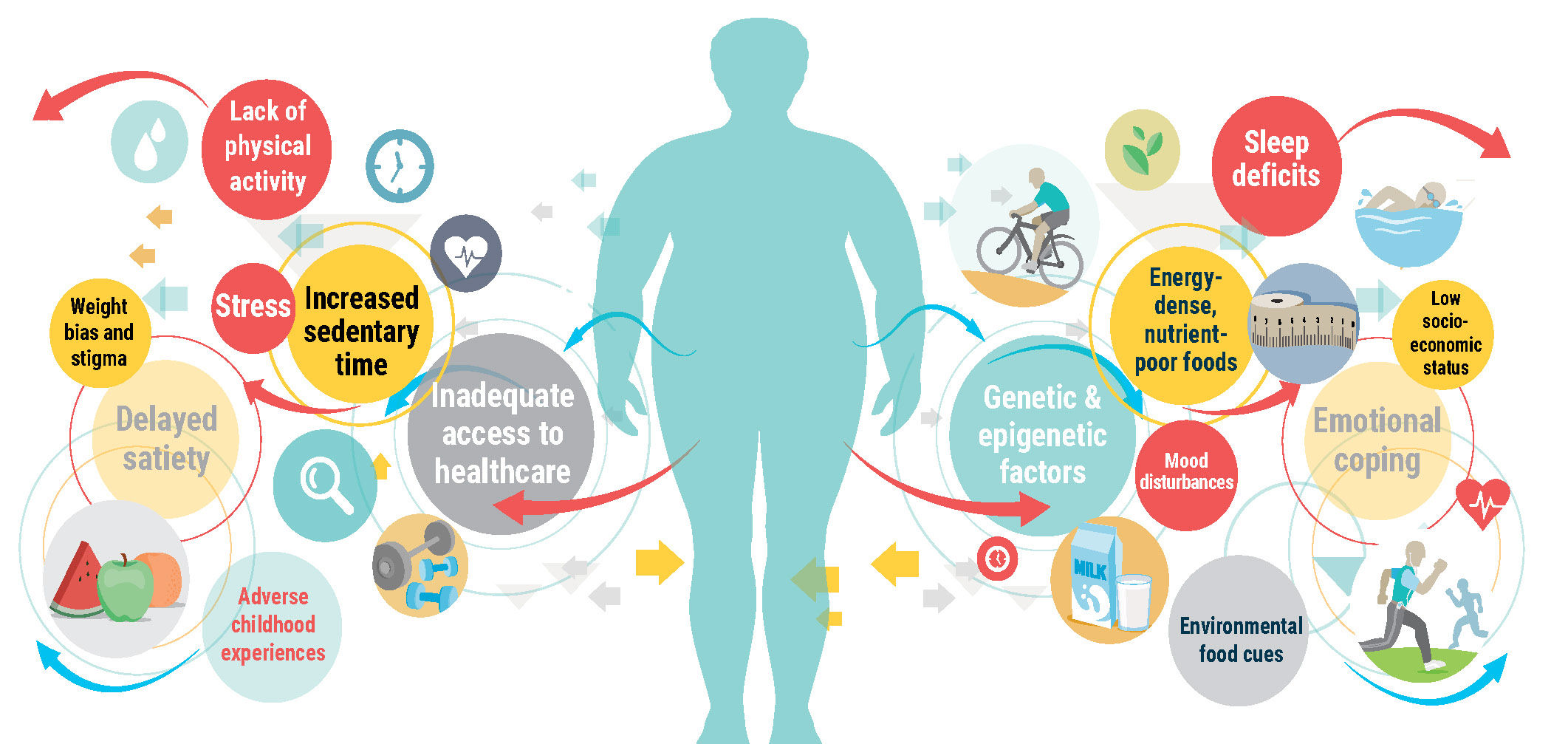
For decades, not only have we have been focused on quick fixes with a lack of long-term strategies, but we've also been facing an oversimplification of the “eat less and move more” solution to our collective fixation on weight loss. In reality, there are many interrelated factors that regulate and influence energy balance.
“Eat less and move more” and “calories in vs. calories out” are the layman’s versions of the energy balance equation, which states that if energy intake equals energy expenditure, the person’s weight will remain unchanged. A person can affect one or both sides of that equation in an effort to impact their weight; consuming more calories than one expends throughout the day results in weight gain, while weight loss is the result of expending more calories than are consumed.
At its most basic level, the equation is accurate, in that it is calorie imbalance that causes either weight gain or weight loss. However, energy balance is dynamic, and there are many factors that influence the way the human body reacts to the foods we eat and the physical activity we perform (Figure 1). In addition, a person’s resting metabolic rate changes as they lose weight, so that less energy is needed to move the lighter body, meaning that body weight will stabilize unless there is a further reduction in caloric intake or increase in caloric expenditure. The complexity of the mechanisms of weight management truly can’t be overstated, which is perhaps why it’s been oversimplified in such a dramatic way.

FIGURE 1. Key factors regulating and influencing energy balance
“The problem with the balance sheet approach to weight loss,” says Cedric X. Bryant, PhD, ACE’s president and chief science officer, “is that every person’s response is going to be different.” Two individuals of the same sex, weight and age can follow the same dietary pattern and physical-activity program and see very different results due to hormonal, metabolic and genetic differences. Couple all of that with daily stressors, sleep deficits and the other factors depicted in Figure 1, and it’s easy to see how much we’ve oversimplified things.
The ultimate issue with the “calories in vs. calories out” narrative is that it places the blame for any failures squarely on the person trying to manage their weight. If the only two factors are eating less and moving more, then having overweight or obesity all comes down to a lack of self-discipline, right?
All health coaches and exercise professionals know that the answer to that question is a resounding “No!”
Reframing the Narrative
So, what can you tell your clients, whose frustration with their inability to manage their weight will only be compounded when they hear that so many elements of this equation are seemingly out of their control?
The key, explains Dr. Bryant, is to treat each client as an individual and identify tweaks that will best set them up for success. Encourage clients to think about the things they may be doing that sabotage their attempts at weight loss or maintenance. Dr. Bryant explains: “Achieving balance is not about evening out the number of calories you're consuming or burning. It comes from creating a lifestyle that works for you, that includes movement you enjoy and food that nourishes your body and enables you to do the things in life that are most important to you, as opposed to simply achieve a particular number on the scale."
It’s important to note that many of the elements depicted in Figure 1 are actually within a client’s control, even if they may fall outside their understanding of weight management. For example, it is within a health coach or exercise professional’s scope of practice to teach clients stress-management techniques such as breathing and mindfulness strategies, and address sleep deficits by timing workouts properly and creating a bedtime routine that will help a client fall asleep and stay asleep at night. Health and exercise professionals can also introduce coping strategies to help their clients combat things like cognitive distortions and negative self-talk.
What this requires is a shift from the directive style of “move more and eat less,” to more of a coaching approach, such as that used in the ACE Mover Method™.
Many of your clients have likely struggled with weight maintenance for many years, so it’s essential that they feel valued and heard, that their feelings are acknowledged and that they are viewed with compassion, not judgement. As Karen Woodmansee, MS, MA, NBC-HWC, owner of Time For You Fitness, LLC, and assistant director of wellness for campus recreation and wellness at East Carolina University, explains, “Sometimes that’s all it takes to empower someone to change their behavior.”
“As a professional, you should try to understand as much as possible about your client,” urges Dr. Bryant. Everyone’s journey is littered with a unique set of hurdles, he explains, so learning how to identify and navigate through and around those hurdles is going to dictate a client’s ability to have a successful journey.
Accepting That Which We Cannot Change
As much as your clients may want to modify their lifestyles to pursue their goals, it’s vital that they also accept those elements of the equation they cannot change. While they may not be able to alter their genetics or childhood experiences with physical activity and nutrition, they can change how they respond to these things. This becomes particularly important as people age and their body no longer responds to diet and exercise as it once did.
This idea of acceptance is especially important for women as they begin perimenopause and menopause. The hormonal changes taking place affect a woman’s ability to lose weight and keep it off. Many women who have never had to worry about their weight before suddenly find themselves facing the reality that what used to work no longer does.
“These hormonal changes are associated with increased body fat, specifically increased abdominal fat,” explains Woodmansee, who is also an ACE Certified Health Coach, Personal Trainer and Group Fitness Instructor. Women who have been active all their lives begin to see their physiology change, their bodies change shape, and their emotions starting to rise and fall.
In addition, their energy levels may begin to falter. “When women go into perimenopause and menopause,” Woodmansee says, “they’re entering a time in their life when they physically start to slow down, and emotionally it becomes less important to do high-intensity interval training and more important to go outside each day and simply move.”
The best approach, according to Woodmansee, is to empower your clients to forgive themselves for slowing down (if they have to) and to have self-compassion for what they are experiencing. In many ways, this comes down to control, as this is a time in life when many women feel as though they are losing control in many ways—of their emotions, their energy levels and how their bodies function. Helping them regain a sense of control is vital to their success. Woodmansee urges her clients not to diminish the positive outcomes of everything they’re doing, and to celebrate their workouts, even if they’re not as intense as they may have been 10 years ago.
That said, if clients are able to work out at a higher intensity, they certainly should do so. Woodmansee is simply suggesting that decisions about workout intensity be coupled with listening to one’s body and a sense of compassion if a less-intense workout is what is needed.
Dr. Bryant suggests reframing clients’ objectives to target what he calls “realistic success.” This involves taking a sustainable approach that is mindful of what each client is experiencing at that particular moment in their life’s journey.
One final note: Health coaches and exercise professionals are not physicians and therefore should never diagnose a client as being in perimenopause or menopause. Be sure to adhere to any guidelines that come from a client’s healthcare provider and collaborate with your client in setting realistic goals and designing sustainable behavior-change programs. A coaching approach allows you to skillfully listen and gather qualitative evidence about how clients are feeling, which should inform the direction of their weight-management programs.
The Role of Calorie Counting
All of the above information is not meant to diminish the value of calorie counting when it is viewed in its proper context and with the proper perspective. Many people want to feel informed and in control of the weight-loss process and counting calories can be very encouraging.
“When counting calories starts to feel like a chore,” says Woodmansee, “it may be time to change gears and try something else.” People should listen to their own intuitive wisdom and learn to become attuned to their needs, physically and mentally. Importantly, Woodmansee suggests that clients have another technique to fall back on if they make the decision to stop counting calories.
In addition, some clients may have a tendency to beat themselves up when they go over their calorie allotment or miss a workout, when they really should be looking at all of their successes along the way. Remind them that these small “failures” are not all that important when viewed through the lens of life-long behavior change.
As Dr. Bryant explains, “The notion that it’s just ‘calories in vs. calories out’ sets people on a journey where they become fixated on trying to become perfect and they lose sight of the fact that it is a process.” To counter this, encourage clients to think about progress as opposed to perfection. No one eats the perfect balance of nutrients, within their calorie limits, while also completing all of their cardio, strength and flexibility exercise each and every day, so it’s important to empower people to forgive themselves for slip-ups and focus on their long-term objectives.
What this requires, according to Woodmansee, is encouraging clients to develop a stronger relationship with themselves. “I would never omit telling a client about the ‘calories in vs. calories out’ strategy,” she says, “but I would always do it with a caveat.” That caveat involves talking about whether calorie counting fits that person’s personality, values and objectives.
While some people find the process empowering, others are quickly overwhelmed and view it as an obstacle to their success. This is an important conversation to have with any client.
Finally, be sure that your clients understand the fact that weight loss is a decidedly non-linear and long-term process. “The human body doesn’t respond to exercise and weight loss in textbook fashion,” explains Sabrena Jo, MS, director of science and research at ACE, “so the psychology behind not getting results as quickly as perhaps we’re promised or as quickly as we think they should come can really take a toll on motivation and the willingness to continue to stick with a program when the results are far in the future, perhaps months down the road.”
Redefining Exercise, Diet and “Ideal Weight”
According to Jo, being bombarded with the quick-fix approach year after year has done a number on people’s mindset. “'Burning calories through exercise for weight loss’ is the wrong message,” she explains. “We have to reframe the way people think about why they’re exercising. It really should be about feeling better and improving your health.”
Every client’s body is going to respond to diet and exercise uniquely. If weight loss is the goal, Jo explains, health and exercise professionals should encourage clients to think about the fact that a 10% weight loss provides remarkable health benefits, including improvements in blood pressure, cholesterol and blood sugar levels.
“Weight loss is always sold to us as a short-term project, and this sets us up for failure,” Jo says. “Instead, we should reframe it as a long-term habit of physical activity and exercise that can help stave off future weight gain and associated health problems.”
Dr. Bryant agrees. “Weight loss isn’t really difficult,” he says. “Most people can lose weight. What is challenging is figuring out how to lose weight and sustain a new body weight for the long haul. That’s why behavior change is so important. If weight loss isn’t the result of an approach that one can sustain and adhere to for a lifetime, it’s going to be temporary. That’s where the frustration comes from.”
To combat this, Dr. Bryant suggests health coaches and exercise professionals help clients find a dietary approach that they can incorporate into their lifestyle and that meets their energy requirements, considers their likes and dislikes, and that they can commit to for the long term. That, he explains, is really a person’s ideal diet.
Health coaches and exercise professionals can turn to the latest guidelines—the 2018 Physical Activity Guidelines for Americans and the 2020-2025 Dietary Guidelines for Americans—as a way to explain this shift in thinking. Taken together, these documents encourage people to make healthy choices one day at a time and one meal at a time—to move more, sit less and make every bite count. By coupling this guidance with a behavior-change plan, clear expectations for success and personally meaningful goals, you can help clients shift their thinking from “calories in vs. calories out” to the quality of the calories they consume and their total movement time for the day.
When it comes to “ideal weight,” we should be defining that differently, as well. Dr. Bryant explains that a person’s ideal weight is the weight at which they can do what they want to do from a physical activity and movement standpoint (meaning that they’re not limited by their body composition), a weight at which they don’t have any health risks associated with their body composition, and a weight that they are able to maintain without doing things that are “unnatural” for them or that are too extreme.
“If a person can check those three boxes, Dr. Bryant says, “then they are probably close to their true or ideal weight.”
Have your clients ask themselves these questions to determine if they are close to their true or ideal weight:
- Can I do what I want from a physical activity and movement standpoint?
- Am I at a weight and body composition that does not increase my health risk?
- Can I maintain my weight without doing things that feel “unnatural” or too extreme?
Every client’s journey is personal to them, which is why taking a coaching approach is so vital. This approach allows for a truly personalized experience, which may or may not involve calorie counting. Help clients reframe their thoughts about their weight, nutrition and exercise, and empower them to set long-term objectives that match their values and lifestyles. The goal is to allow clients to avoid getting so caught up in the numbers that they lose sight of what’s truly important—achieving a level of health, fitness and overall wellness that allows them to enjoy their chosen lifestyle.





 by
by 






